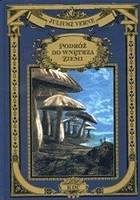 Tytuł: Podróż do wnętrza Ziemi (Wydana po polsku także jako Podróż do środka ziemi, Wyprawa do wnętrza Ziemi, Podróż podziemna : przygody nieustraszonych podróżników)
Tytuł: Podróż do wnętrza Ziemi (Wydana po polsku także jako Podróż do środka ziemi, Wyprawa do wnętrza Ziemi, Podróż podziemna : przygody nieustraszonych podróżników)
Tytuł oryginału: Voyage au centre de la Terre
Tytuł Angielski: Journey to the Center of the Earth (wydawane także jako A Journey to the Centre of the Earth i A Journey into the Interior of the Earth)
Autor(zy): Juliusz Verne
Tłumaczenie: Andrzej Zydorczak, Ludmiła Duninowska, wielu innych.
Rok wydania: 1864 (FR), 1865 (PL)
Wydawnictwo: Pierre-Jules Hetzel (FR)
Dlaczego w bazie: Książka przygodowa o statusie klasyka. Znalazły się w niej trzy wzmianki o żółwiach, wszystkie przytaczamy poniżej (polskie faragmenty w tłumaczeniu pani Ludmiły Duninowskiej, angielskie w tłumaczeniu Fredericka Amadeusa Mallesona):
Jednak fantazja ponosi mnie i zapuszczam się w cudowne hipotezy paleontologii. Śnię na jawie. Marzy mi się, że widzę na powierzchni wód owe ogromne, pradawne żółwie, podobne do pływających wysp.1
Hans chce wykorzystać wiatr i zwiększyć szybkość, aby uciec od niebezpiecznych sąsiadów, lecz dostrzega z przeciwnej strony niemniej groźnych nieprzyjaciół, mianowicie żółwia szerokości czterdziestu stóp oraz węża długości trzydziestu, który wychyla olbrzymią głowę ponad fale.
Nie sposób umknąć! Potwory zbliżają się, krążą wokół tratwy z szybkością, jakiej nie mogłyby dorównać najszybsze pojazdy, kreślą naokoło niej koncentryczne koła. Trzymam strzelbę w pogotowiu. Ale co może zdziałać kula, skoro ciała tych zwierząt pokryte są niezwykle grubą skórą!
Po prostu oniemieliśmy z przestrachu. Znów gady przybliżają się. Z jednej strony krokodyl, z drugiej wąż. Reszta morskiego stada znikła. Już-już mam zamiar strzelać. Hans powstrzymuje mnie gestem ręki. Obydwa potwory mijają tratwę w odległości pięćdziesięciu sążni, rzucają się na siebie i w rozwścieczeniu nie widzą nas wcale.
Walka rozgrywa się zaledwie o sto sążni od nas. Widzimy wyraźnie zmagające się bestie.
Ale teraz wydaje mi się, że i inne zwierzęta biorą udział w walce – morświn, wieloryb, jaszczur i żółw, dostrzegam je co chwila. Pokazuję Islandczykowi. Ten zaprzecza ruchem głowy.
– Tva – mówi.
– Co? Dwa?! Twierdzi, że są tylko dwa potwory…
– Ma rację! – woła wuj, który przez cały czas nie odrywał lunety od oczu.
– Cóż znowu!
– Tak, jeden z nich ma paszczę morświna, głowę jaszczura, zęby krokodyla i to właśnie wprowadziło nas w błąd. To Ichtiosaurus, najgroźniejszy gad okresu jurajskiego.
– A drugi?
– Drugi to Plesiosaurus, gad o długiej jak u węża szyi, straszliwy wróg tamtego.2
Zostawiliśmy Hansa przy jego zajęciach i ruszyliśmy w drogę. Przestrzeń między linią fal a podnóżem skał była dość rozległa; trzeba było iść pół godziny, żeby dotrzeć do granitowych ścian. Stopy nasze miażdżyły niezliczoną ilość muszli różnych kształtów i wielkości, które służyły ongiś za mieszkania skorupiakom z najwcześniejszych epok – Zauważyłem również olbrzymie pancerze – średnica ich przekraczała nieraz piętnaście stóp. Należały do gigantycznych glyptodonów z epoki plioceńskiej; współczesny żółw jest tylko miniaturową ich imitacją. 3















1. Nevertheless, though I could neither see nor discover anything, my imagination carried me away into wild hypotheses. I was in a kind of waking dream. I thought I saw on the surface of the water those enormous antediluvian turtles as big as floating islands. Upon those dull and somber shores passed a spectral row of the mammifers of early days, the great Liptotherium found in the cavernous hollow of the Brazilian hills, the Mesicotherium, a native of the glacial regions of Siberia.
2. Hans wants to tack to get away from this dangerous neighbourhood; but he sees on the other hand enemies not less terrible; a tortoise forty feet long, and a serpent of thirty, lifting its fearful head and gleaming eyes above the flood.
Flight was out of the question now. The reptiles rose; they wheeled around our little raft with a rapidity greater than that of express trains. They described around us gradually narrowing circles. I took up my rifle. But what could a ball do against the scaly armour with which these enormous beasts were clad?
We stood dumb with fear. They approach us close: on one side the crocodile, on the other the serpent. The remainder of the sea monsters have disappeared. I prepare to fire. Hans stops me by a gesture. The two monsters pass within a hundred and fifty yards of the raft, and hurl themselves the one upon the other, with a fury which prevents them from seeing us.
At three hundred yards from us the battle was fought. We could distinctly observe the two monsters engaged in deadly conflict. But it now seems to me as if the other animals were taking part in the fray—the porpoise, the whale, the lizard, the tortoise. Every moment I seem to see one or other of them. I point them to the Icelander. He shakes his head negatively.
„Tva,” says he.
„What two? Does he mean that there are only two animals?”
„He is right,” said my uncle, whose glass has never left his eye.
„Surely you must be mistaken,” I cried.
„No: the first of those monsters has a porpoise’s snout, a lizard’s head, a crocodile’s teeth; and hence our mistake. It is the ichthyosaurus (the fish lizard), the most terrible of the ancient monsters of the deep.”
„And the other?”
„The other is a plesiosaurus (almost lizard), a serpent, armoured with the carapace and the paddles of a turtle; he is the dreadful enemy of the other.”
3. And leaving Hans to his work we started off together. The space between the water and the foot of the cliffs was considerable. It took half an hour to bring us to the wall of rock. We trampled under our feet numberless shells of all the forms and sizes which existed in the earliest ages of the world. I also saw immense carapaces more than fifteen feet in diameter. They had been the coverings of those gigantic glyptodons or armadilloes of the pleiocene period, of which the modern tortoise is but a miniature representative.
